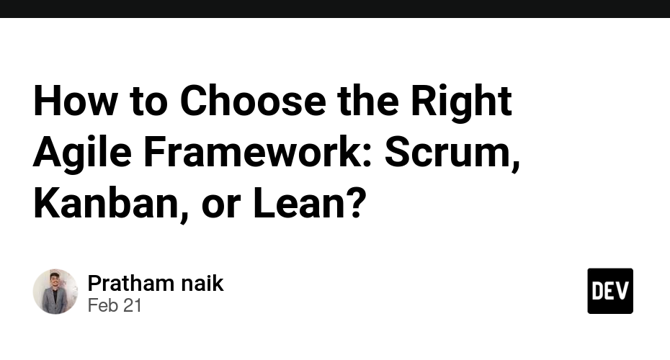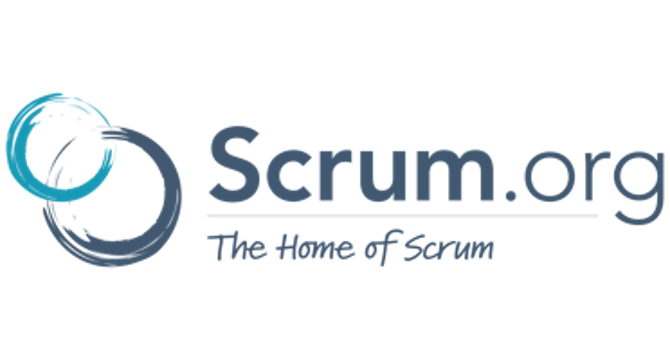Agile Methodology News
Dev
51

Image Credit: Dev
How to Choose the Right Agile Framework: Scrum, Kanban, or Lean?
- Agile project management enables teams to improve efficiency, adapt to change, and deliver high-value results.
- Scrum follows a structured approach with predefined roles, sprints, and meetings, making it ideal for software development projects.
- Kanban focuses on continuous workflow visualization, allowing teams to manage ongoing tasks and improve process efficiency.
- Lean emphasizes waste reduction and process optimization, making it suitable for organizations seeking operational streamlining and high value delivery.
Read Full Article
3 Likes
Scrum
157

Image Credit: Scrum
Scrum Adjustments: The Difference Between Learning and Stagnation.
- Scrum adjustments in the context of the Scrum Guide mean making small, evidence-based tweaks to improve effectiveness.
- Adjustments happen in multiple areas of Scrum, including the Product Backlog, Sprint Backlog, Definition of Done, Sprint Planning, user interaction, and refinement practices.
- The absence of adjustments indicates a lack of leveraging empiricism and a risk of stagnant progress.
- Effective adjustments should be incremental, goal-oriented, and data-driven, avoiding chaotic and directionless changes.
Read Full Article
9 Likes
Medium
233

Image Credit: Medium
Adopting Agile: Understanding Organizational Appetites
- Adopting Agile: Understanding Organizational Appetites
- Agile adoption can be categorized into different stages: Early Explorers, Experimenters, Enthusiasts, and Innovators.
- Each stage has its own challenges, such as resistance to change, maintaining consistency, sustaining momentum, and staying ahead of industry trends.
- Strategies for effective Agile adoption include starting small, building a coalition of advocates, providing structured guidance, focusing on leadership support, and leveraging Agile as a strategic asset.
Read Full Article
14 Likes
Testim.io
416

Image Credit: Testim.io
Puppeteer Testing Introduction: End-To-End Testing Made Easy
- End-to-end testing involves testing the complete flow of an application from start to finish, and Puppeteer offers an efficient way to perform such tests.
- Puppeteer, developed by the Google Chrome dev team, can automate various actions on a webpage like clicking, typing, and more, simplifying the testing process.
- To start end-to-end testing with Puppeteer, you need Node.Js, Jasmine Node.js package, Puppeteer Node.js package, and basic JavaScript knowledge.
- Setting up a local server for running the login page involves installing the http-server node package and configuring it to serve the HTML file.
- Installing Jasmine for JavaScript testing includes commands to add the Jasmine package and set up the test script in the package.json file.
- Installing Puppeteer is a straightforward process where you add it to your project's dependencies and configure it in the package.json file.
- Writing and running tests with Puppeteer involves creating test scenarios like verifying success and error messages on a login page.
- The tests are executed using Puppeteer functions to interact with the login page elements and validate expected outcomes.
- Running the tests using npm test should yield successful results if the setup is correct, verifying the effectiveness of the end-to-end testing.
- Puppeteer testing offers streamlined procedures for automating tests, improving consistency, and enhancing the efficiency of end-to-end testing processes.
Read Full Article
25 Likes
Discover more
- Programming News
- Software News
- Web Design
- Devops News
- Open Source News
- Databases
- Cloud News
- Product Management News
- Operating Systems News
- Computer Engineering
- Startup News
- Cryptocurrency News
- Technology News
- Blockchain News
- Data Science News
- AR News
- Apple News
- Cyber Security News
- Leadership News
- Gaming News
- Automobiles News
Alvinashcraft
69

Image Credit: Alvinashcraft
Dew Drop – February 20, 2025 (#4366)
- Microsoft announced the Chroma DB C# SDK and Majorana 1 quantum processor.
- .NET Rocks! featured Uno Hot Design and GitHub Copilot enhancements.
- Updates in Deno 2.2, AWS Documentation, and Rust Beta SDK for Azure were highlighted.
- New MAUI Bullet Chart for product sales data tracking was introduced.
- MSVC C++ Code Analysis updates and AutoMapper 14.0 release were discussed.
- Arm Extension for GitHub Copilot and Azure AI Foundry Labs were unveiled.
- The article covers various topics like adaptive vs. responsive design and AI agent building.
- Xcode IDE update, TypeScript enums in React Native guide, and Flutter Navigation topic were featured.
- Screencasts on WinForms projects and Majorana 1 explanation were showcased.
- Podcasts on tech topics like Nuxt, quantum computing, and Scrum strategies were shared.
Read Full Article
4 Likes
Scrum
316

Image Credit: Scrum
Scrum Teams - How to enable self-management?
- Scrum relies on self-managing teams to make quick decisions, take ownership, and create value to meet evolving customer needs.
- However, true self-managing teams are often rare in the software industry, posing a challenge to the implementation of Scrum principles.
- The balance between autonomy and alignment is crucial for effective self-management within teams.
- Setting boundaries is essential for fostering self-management, as it helps define ownership, responsibilities, and decision-making frameworks.
- Establishing boundaries through artifacts like Product Vision, Definition of Done, decision-making authority, and team working agreements is key.
- Organizational constraints also play a role in shaping the boundaries for self-managing teams.
- The boundaries of self-management are not static and should evolve as team members mature and understand their context better.
- Involving the team in defining boundaries, taking incremental steps, and providing clarity and context are essential for successful self-management.
- Empowering team members with accountability is crucial for fostering a culture of ownership and responsibility.
- Leaders must communicate that boundaries in self-management are not limitations but guidelines for creating the right culture and fostering self-management effectively.
Read Full Article
19 Likes
Dev
109

Image Credit: Dev
May Kanban Be With You: Practical Case Study
- The article discusses a practical case study of implementing Kanban in a technical team to improve efficiency and visibility in managing work.
- The team, responsible for licensing products and managing daily data reports from servers, faced challenges with Scrum, leading to a lack of control over workflow and heavy workloads.
- Visualizing workflow and transitioning to Kanban led to improved understanding and communication within the team.
- Key steps in introducing Kanban included Kanban evangelism, defining service classes, setting WIP limits, and understanding workload origins.
- The team implemented Expedite, Fixed Date, Standard, Bugs, and Intangible service classes to prioritize tasks based on business value and technical impact.
- WIP limits were set for engineers, workflow stages, and expedited tasks to maintain a steady workflow and prevent overload.
- Analyzing workload dynamics helped the team manage expectations, plan better, and reserve buffers for varying request types.
- Improving stakeholder satisfaction through cadence meetings, lead time optimization, and backlog triage enhanced communication and prioritization within the team.
- Metrics like Lead Time and Cycle Time were utilized to optimize task completion, reduce backlog size, and streamline development processes.
- By implementing Kanban, the team achieved significant improvements in lead time, backlog size, task completion efficiency, and stakeholder satisfaction.
Read Full Article
6 Likes
Scrum-Master-Toolbox
293

Substack Week: The Shared Ownership Challenge, Understanding Clear Accountability in Engineering Teams With Rafa Páez
- In this episode, Rafa Páez discusses shared ownership challenges and clear accountability in engineering teams.
- Shared ownership in teams can lead to ambiguity in responsibility and accountability, resulting in missed deadlines and conflicts.
- The bystander effect explains how team members may assume others will take charge, leading to inaction and reduced productivity.
- The Directly Responsible Individual (DRI) framework ensures clear ownership and accountability for significant initiatives.
- Assigning DRIs based on skills and empowering them to make decisions are crucial for successful implementation.
- Leaders implementing the DRI framework must avoid anti-patterns like bottlenecks, erosion of collaboration, and overuse of the framework.
- Building a culture of accountability involves clear communication, supporting DRIs, and enabling effective decision-making while preserving teamwork.
- Resources for further study include the Gitlab handbook on the DRI concept and the book 'Extreme Ownership' by Jocko Willink.
- Rafa Páez, an experienced Engineering Leader, emphasizes the importance of skillful DRI assignments and fostering collaboration within teams.
- Rafa Páez has over 20 years of experience, specializes in leading high-performing teams, and connects with readers through his Substack newsletter.
Read Full Article
17 Likes
Testim.io
348

Image Credit: Testim.io
Why Shift-Left Testing? Pros and Cons
- Shift-left testing involves planning testing activities in advance and starting them earlier in the software development life cycle (SDLC). It transforms traditional QA into QE: Quality Engineering.
- Shift-left testing includes activities like assisting developers with unit testing, automating integration test cases, employing virtualized services, and prioritizing feedback.
- Benefits of shift-left testing include cost reduction, increased efficiency, higher quality, improved competitiveness, and attracting top talent in the industry.
- Challenges of shift-left testing involve the need for a cultural shift within teams, potential bottlenecks in testing phases, and the complexity of aligning various roles and processes.
- To overcome bottlenecks, service virtualization and automation tools like Jenkins can be utilized to streamline testing processes and eliminate errors earlier in development.
- Shift left testing can enhance collaboration between testers and developers, leading to a higher level of quality and allowing testers to focus on strategic testing tasks.
- Shift-left testing enables testers to coach developers on writing better code, perform business cases, penetration testing, and implement smarter testing solutions.
- The approach of shift-left testing provides an overall improvement in the quality of software products, ensuring a more efficient and strategic testing process.
Read Full Article
20 Likes
Kanbanzone
45

Image Credit: Kanbanzone
Streamlining Enhancements and Defects with Kanban Card Templates
- User stories, combined with acceptance criteria, have improved communication and work completion in software teams.
- Standardized templates for enhancements and defects ensure clear communication, save time, and foster teamwork.
- Using the user story format to capture enhancements provides a clear and concise foundation for productive discussions.
- A user story card template enforces a structured approach to enhancement requests, leading to clarity and consistency.
- Defects can be effectively tracked using a format outlining steps to reproduce, current behavior, and expected behavior.
- Consistency in defect tracking templates saves time, avoids misunderstandings, and speeds up issue resolution.
- Standardized templates create a common language, improving communication, collaboration, and efficiency within teams.
- Benefits include faster issue resolution, improved communication, and stronger collaboration.
- Templatized Kanban cards demonstrate an effective approach to managing enhancements and defects smoothly.
- Reflect on and refine your team's processes to enhance collaboration and efficiency based on what works best for your team.
Read Full Article
2 Likes
Scrum
238

Image Credit: Scrum
WALL STREET FOR PRODUCT PEOPLE: BOOST YOUR INFLUENCE
- The article discusses the importance of product teams speaking the language of Wall Street to improve collaboration with decision-makers.
- By leveraging financial concepts, such as ROI and financial statements, product owners can enhance communication with sponsors.
- It emphasizes the similarity between managing a product and running a business, highlighting the need for clear metrics and transparency.
- The communication gap between sponsors and product teams is identified as a common pain point, leading to underperforming products.
- Introducing Wall Street 101, the article explains the relevance of balance sheets, cash flow, and income statements for product management.
- Balance sheets are compared to a snapshot of a business, detailing assets (what we own) and debt/capital (what we owe).
- Cash flow is likened to a live feed (TikTok) showing the inflow and outflow of money, crucial for tracking performance and identifying bottlenecks.
- Income statements, or P&L, demonstrate how activities translate into wealth by showing revenue streams, costs, and net profit, offering insights for decision-making.
- Understanding and applying these financial principles can significantly enhance a product manager's influence within the organization.
- By aligning product metrics with financial concepts, product teams can effectively demonstrate the value and impact of their work.
- Incorporating financial literacy into product management can lead to more strategic decision-making and improved collaboration between teams.
Read Full Article
14 Likes
Medium
91

Image Credit: Medium
Drone Mystery
- The company currently serves 500 residential customers and 20 small commercial clients, generating $1.2 million in annual revenue.
- Three potential opportunities for expansion using drone technology: Automated Lawn Health Analysis, 3D Landscape Design Visualization, and Drone-Based Pest Control Monitoring.
- Limited budget and workforce, can only pursue one opportunity.
- Factors to consider: revenue potential, customer interest, required investment, and impact on existing services.
Read Full Article
5 Likes
Medium
444

Mastering Agile with a Remote Team
- Communication is vital in agile and daily standups are recommended. Look for creative ways to engage with each member on standups.
- Set up virtual collaboration rooms to mimic in-office spaces and improve project collaboration, file sharing, and effective communication.
- Organize teabreaks, virtual happy hours, and water cooler conversations to foster team building and bonding.
- Hold regular retrospectives to address challenges of remote work and ensure open communication and problem-solving within the team.
Read Full Article
26 Likes
Medium
100

Image Credit: Medium
The Hidden Psychological Aspects of Product Ownership
- Psychological forces play a significant role in product ownership and success.
- Cognitive biases and emotional intelligence shape decision-making and value-driven product building.
- The Endowment Effect leads to overvaluing items simply because we own them.
- The Paradox of Choice suggests that too many options can overwhelm users, leading to decision paralysis and dissatisfaction.
Read Full Article
6 Likes
Alvinashcraft
320

Image Credit: Alvinashcraft
Dew Drop – February 19, 2025 (#4365)
- Top links shared in Dew Drop on February 19, 2025 include insights on .NET, Edge features, AI experiences, ASP.NET Core, JavaScript classes, Terraform, and more.
- Web & Cloud Development highlights cover topics like ESLint supporting CSS linting, Auth0 integration in B2B Blazor apps, ASP.NET Core features, middleware automation, AI-driven text suggestions, and securing workload identities.
- Visual Studio & .NET section features articles on writing a .NET Garbage Collector, C# Dev Kit enhancements, managing Worker Applications, ConcurrentDictionary nuances, and optimizing Code Analysis.
- AI advancements in data storage, scalable AI agents, Azure AI Foundry automation, AI toolkits, LLMs benefits, OpenAI updates, and Deep Research expansion are elaborated on in the AI category.
- Design, Methodology & Testing segment discusses unit testing, user data protection, pie chart best practices, resetting expectations, and automating tasks for streamlined processes.
- Mobile, IoT & Game Development insights include updates for Ionic projects, consuming Swift Packages, AI-assisted coding in iOS development, Meta's metaverse potential, and Programmable IO on the Pi Pico.
- Screencasts & Videos section features PowerShell terminal customization, AI programming language discussions, GitHub Copilot updates, and AI insights with Fabian Williams.
- Podcasts cover topics like Managed DevOps Pools, Agile team leadership, Microsoft CTO insights, grammar nuances, and GIS understanding.
- Community & Events share upcoming conferences, free training webcasts, industry layoffs, Microsoft 365 Community Call updates, and IT skills auditing.
- Database insights delve into AI embeddings in SQL Server, considerations for index key column order, and database management systems.
- SharePoint, M365 & MS Teams discuss data import with Copilot in Excel and meeting management streamlining with Copilot.
Read Full Article
19 Likes
For uninterrupted reading, download the app